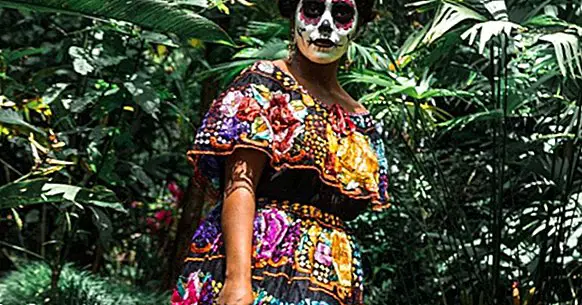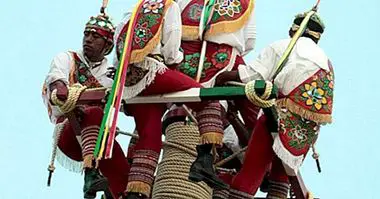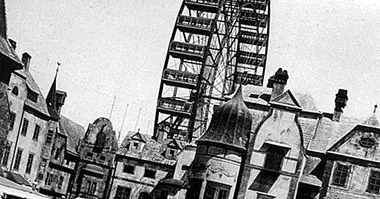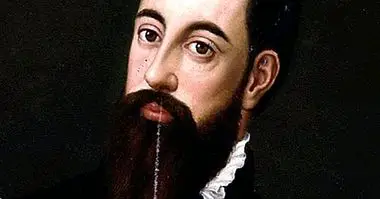10 short Mexican legends based on folklore
The short Mexican legends are famous for their mystical content and the cultural syncretism that shapes them. They are an important part of popular culture, since they represent and at the same time transmit values and imaginaries about life and death, masculine and feminine, morals and injustice, sanctions and rewards.
In this article you will find 10 short Mexican legends, as well as a brief description about this type of narrative and what are the functions that they fulfill.
- Related article: "The 5 differences between myth and legend"
10 short Mexican legends
The legends are the stories that are transmitted from generation to generation through the spoken word, and to a lesser extent through the texts. It's about stories that may include historical, fantastic or supernatural elements and characters , that interact with people and impact the phenomena of everyday life. They have the function of explaining human situations or nature, and have the ability to represent an important part of the imaginaries, values and social conventions.
For this reason, the legends vary according to the place where they emerge and the culture that transmits them. In Mexican legends we can find a wide repertoire of symbolic images and mythical representations that fulfill important social functions. Although there are many more, below we will see 10 short Mexican legends.
1. The weeping woman
Legend has it that a long time ago there was a woman who, in an attempt to take revenge on the man she loved, murdered her children by drowning them in a river. Immediately afterwards he repented, and before guilt decided to commit suicide.
Since then, he wanders through the streets of different cities at midnight (especially appears near places where there is water), and repeats incessantly "Oh my children!". For this reason she is known as "La Llorona"
The roots of this woman, and the reasons that lead her to take revenge, vary according to the version . There are also those who say that it is a woman who appears specifically to drunken men and through fright punishes them.
- Maybe you're interested: "The 10 best short legends (for children and adults)"
2. The Popocatépetl and the Iztaccíhuatl
In the center of Mexico there are two volcanoes called Popocatépetl and Iztaccíhuatl, just as an Aztec warrior had been named, and the daughter of one of the chiefs, respectively. Popocatépetl had to go to war, but he promised Iztaccihuatl that he would return as soon as possible.
However, another warrior who had heard them and was also in love with the chief's daughter, told Iztaccihuatl that Popocatépetl had died in combat, although this had not happened. The sadness was such that Iztaccíhuatl decided to take his own life, and when Popocatepetl returned and did not find his beloved, he did the same. In a sign of shuddering, the gods They decided to reunite them again in the form of two great volcanoes .
3. The alley of the kiss
This legend, typical of the city of Guanajuato, tells that a suspicious father had separated his daughter Carmen from her lover. To such an extent he disliked the loving bond, which promised to marry her with another man, richer and more prestigious, who lived outside the country. Before fulfilling it, she locked the daughter in one of the typical houses of the city, which are characterized by being high and one very close to the other, divided only by a small alley.
Fortunately for the lovers, the window of Carmen's room adjoined that of a house for sale, which was quickly acquired by the lover, as the only solution for their reunion. So the lovers could be together again .
But, shortly after, they were discovered by the father, who, seized with fury, nailed a knife to his daughter's chest. His beloved could only kiss him goodbye. Since then, this alley has been baptized as the kissing alley, and it is a tradition for couples who go through it to kiss each other right there.
4. The Mayan hummingbird
They say When the Mayan gods created the earth, each animal was assigned a task determined. But when they finished, they realized that there was no one to transport ideas, thoughts and desires between them.
The mud and corn were over, which are the materials from which the rest of the things originated. They only had a small jade stone, so they decided to carve it and create a small arrow. When they finished, they blew on it and flew off. They had thus created a new being, which they called x'ts'unu'um, which means hummingbird.
5. La Mulata de Córdoba
La Mulata de Córdoba was a woman condemned to the stake by the Holy Office, near the coast of eastern Mexico. The power of eternal youth was attributed to her and she was the advocate of impossible cases, such as those of unemployed workers and single women. She was always surrounded by men who easily fell in love with her and lost the path of righteousness. First of all, they said he had pacts with the devil and that he even received it in his own home.
Until she was arrested by the Court of the Holy Inquisition, being accused of practicing witchcraft and having arrived on a ship that had not moored on any beach. One night before serving his sentence and while he was in a cell, he requested a piece of coal, with which he drew a ship and was able to fly out of the bars. Upon arrival, the guards could only find a smell of sulfur, whose existence is related to our days.
6. The dead man's alley
This legend tells that in the city of Oaxaca, southern Mexico , a man whose task was to light the oil lamps of the city, was killed right there. He had finished his work, but soon realized that he needed to light one, so he returned just before returning home. He died mysteriously and, since then, the legend says that his soul appears after 9 o'clock at night, to walk the alley of oil lamps.
7. The nagual
Since pre-Hispanic times, several of the gods that have been part of the Mexican culture have had the ability to change from the human form to that of an animal. This faculty was later moved to witches, witches and shamans, who they acquire the skills of the animal in which they transform and they use it in favor of the community.
Thus, the legend says that nahuales appear constantly to people, especially at midnight and taking the form of common animals.
8. The devil's alley
Located in Mexico City, they say that in this alley the devil himself appears. A skeptical man decided to check such a story , which encouraged one night to walk around. It was a dark place where some trees were found.
When he was not even halfway there, he stopped because he thought he saw a shadow behind a tree. Then he continued walking, and they say that the shadow approached him, taking the shape of a man who laughed intensely. The once skeptical man ran away, but began to feel the ground sink and catch him hard to prevent his escape.
However, he managed to escape and transmit his encounter with the devil whom he met along the way. In other versions it is said that the appearance was towards a drunk man and that, to avoid it, it is necessary to deposit daily jewels and offerings under the tree where it appears.
9. The Island of the Dolls
In Xochimilco, one of the delegations of Mexico City where there is a large lake with numerous trajineras, it is said that a man named Julian Santana collected abandoned dolls .
The man lived in one of these trajineras, and the reason he put the figures together was to scare away the lake spirits. Specifically, Don Julián offered these dolls as a symbol of peace to scare away the spirit of a girl who died drowned right there. Currently there is a small island with dolls collected by Don Julián in the channels of Xochimilco, and they say that the soul of this man constantly returns to take care of them.
10. Princess Donají
This legend tells that Cosijopi, the last governor of the Isthmus of Tehuantepec, in southern Mexico, had a daughter whom he called Donají. During a war between the Mixtecs and the Zapotecs, Donají was captured as a hostage and later decapitated. Even though his body was buried, the place where his head lay was never revealed.
Later, a shepherd who was passing through the Oaxacan sierra pulled out a lily (a wild flower also called a lily). In doing so, he found what appeared to be a human head beneath the earth, and in rescuing it, he led her to reunite with his body in the temple of Cuilapam. It was then that the soul of the Princess Donají could finally rest in peace.



















